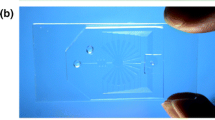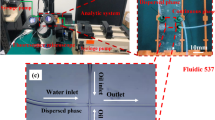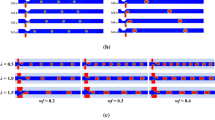Abstract
We presented a microfluidic device for the preparation of monodisperse microdroplets with a small volume of samples or reagents, which is power-free, user-friendly and based only on a highly portable syringe. Our method requires only hand-operated syringes and sharpened capillaries without any complicated experimental setups, making the entire system portable and user-friendly for non-technical users. Vacuum is generated by pulling the plunger of the syringe on site, and fluid is generated by vacuum. The droplet size can be flexibly controlled by adjusting the size of micropores and capillary or vacuum degree. More potentially, microliter samples or reagents can also be prepared from it into emulsions. Unlike traditional methods, our device is self-activated, avoiding the need for external power supply while ensuring fewer samples or reagents consumption, simplifying operations and saving costs, facilitating immediate diagnostic testing or field trace substance detection.









Similar content being viewed by others
References
Lee C-H, Hong C-C (2016) Easy-to-attach vacuum modules with biochips for droplets generation from small sample volumes. Microfluid Nanofluid 20. doi:https://doi.org/10.1007/s10404-016-1821-3
Wong WSY, Liu G, Tricoli A (2017) Superamphiphobic bionic proboscis for contamination-free manipulation of nano and core-shell droplets. Small 13. doi:https://doi.org/10.1002/smll.201603688
Kim B, Hahn YK, You D, Oh S, Choi S (2016) A smart multi-pipette for hand-held operation of microfluidic devices. Analyst 141:5753–5758. doi:https://doi.org/10.1039/c6an00681g
Chakrabarty K, Fair RB, Zeng J (2010) Design tools for digital microfluidic biochips: toward functional diversification and more than moore. IEEE Trans Comput Aided Des Integr Circuits Syst 29:1001–1017. doi:https://doi.org/10.1109/tcad.2010.2049153
Dutka F, Opalski AS, Garstecki P (2016) Nano-liter droplet libraries from a pipette: step emulsificator that stabilizes droplet volume against variation in flow rate. Lab Chip 16:2044–2049. doi:https://doi.org/10.1039/c6lc00265j
Zhu X et al (2004) Arrays of horizontally-oriented mini-reservoirs generate steady microfluidic flows for continuous perfusion cell culture and gradient generation. Analyst 129. doi:https://doi.org/10.1039/b407623k
Wang Y et al (2013) Exploring a direct injection method for microfluidic generation of polymer microgels. Lab Chip 13. doi:https://doi.org/10.1039/c3lc41385c
Yew M et al (2019) Synthesis of microcapsules for carbon capture via needle-based droplet microfluidics. Energy Procedia 160:443–450. doi:https://doi.org/10.1016/j.egypro.2019.02.179
Islam MM, Loewen A, Allen PB (2018) Simple, low-cost fabrication of acrylic based droplet microfluidics and its use to generate DNA-coated particles. Sci Rep 8. doi:https://doi.org/10.1038/s41598-018-27037-5
Crawford EA, Esen C, Volmer DA (2016) Real time monitoring of containerless microreactions in acoustically levitated droplets via ambient ionization mass spectrometry. Anal Chem 88:8396–8403. doi:https://doi.org/10.1021/acs.analchem.6b01519
Jamieson EJ, Fewkes CJ, Berry JD, Dagastine RR (2019) Forces between oil drops in polymer-surfactant systems: Linking direct force measurements to microfluidic observations. J Colloid Interface Sci 544:130–143. doi:https://doi.org/10.1016/j.jcis.2019.02.051
Smith GT, Li L, Zhu Y, Bowden AK (2018) Low-power, low-cost urinalysis system with integrated dipstick evaluation and microscopic analysis. Lab Chip 18:2111–2123. doi:https://doi.org/10.1039/c8lc00501j
Park S-Y, Wu T-H, Chen Y, Teitell MA, Chiou P-Y (2011) High-speed droplet generation on demand driven by pulse laser-induced cavitation. Lab Chip 11. doi:https://doi.org/10.1039/c0lc00555j
Pang Y, Du Y, Wang J, Liu Z (2019) Generation of single/double Janus emulsion droplets in co-flowing microtube. Int J Multiph Flow 113:199–207. doi:https://doi.org/10.1016/j.ijmultiphaseflow.2019.01.011
Lin P et al (2019) Capillary-based microfluidic fabrication of liquid metal microspheres toward functional microelectrodes and photothermal medium. ACS Appl Mater Interfaces 11:25295–25305. doi:https://doi.org/10.1021/acsami.9b03007
Li T, Zhao L, Liu W, Xu J, Wang J (2016) Simple and reusable off-the-shelf microfluidic devices for the versatile generation of droplets. Lab Chip 16:4718–4724. doi:https://doi.org/10.1039/c6lc00967k
Li C, Xu J, Ma B (2014) A self-powered microfluidic monodispersed droplet generator with capability of multi-sample introduction. Microfluid Nanofluid 18:1067–1073. doi:https://doi.org/10.1007/s10404-014-1497-5
Lian Z (2019) High throughput fabrication of microdroplets using needle based microfluidic system.BOOK
** SH, Kim T, Oh D, Kang KK, Lee CS (2019) Preparation of monodisperse pegda microparticles using a dispensing needle based microfluidic device. Korean Chem Eng Res 57:58–64. doi:https://doi.org/10.9713/kcer.2019.57.1.58
Tran TM, Cater S, Abate AR (2014) Coaxial flow focusing in poly(dimethylsiloxane) microfluidic devices. Biomicrofluidics 8:016502. doi:https://doi.org/10.1063/1.4863576
Wang Y et al (2013) Exploring a direct injection method for microfluidic generation of polymer microgels. Lab Chip 13:2547–2553. doi:https://doi.org/10.1039/c3lc41385c
Wu W (2018) A pressure-driven gas-diffusion/permeation micropump for self-activated sample transport in an extreme micro-environment. Analyst 143:4819–4835. doi:https://doi.org/10.1039/c8an01120f
Riefler N, Wriedt T (2008) Generation of monodisperse micron-sized droplets using free adjustable signals. Part Part Syst Charact 25:176–182. doi:https://doi.org/10.1002/ppsc.200700038
Jiang Y et al (2018) A novel mechanism for user-friendly and self-activated microdroplet generation capable of programmable control. Analyst 143:3798–3807. doi:https://doi.org/10.1039/c8an00035b
Suvarnapathaki S et al (2018) Generation of cell-laden hydrogel microspheres using 3D printing-enabled microfluidics. J Mater Res 33:2012–2018. doi:https://doi.org/10.1557/jmr.2018.77
Wu P et al (2014) A 3D easily-assembled micro-cross for droplet generation. Lab Chip 14:795–798. doi:https://doi.org/10.1039/c3lc51126j
Zhang Y (2016) Droplet generation and sampling on demand with peristaltic pum** systems.BOOK
Zhang K et al (2010) A gravity-actuated technique for flexible and portable microfluidic droplet manipulation. Microfluid Nanofluid 9:995–1001. doi:https://doi.org/10.1007/s10404-010-0611-6
Abate AR, Weitz DA (2011) Syringe-vacuum microfluidics: A portable technique to create monodisperse emulsions. Biomicrofluidics 5. doi:https://doi.org/10.1063/1.3567093
Chen IJ, Wu T, Hu S (2018) A hand-held, power-free microfluidic device for monodisperse droplet generation. MethodsX 5:984–990. doi:https://doi.org/10.1016/j.mex.2018.08.008
Xu L, Lee H, Jetta D, Oh KW (2015) Vacuum-driven power-free microfluidics utilizing the gas solubility or permeability of polydimethylsiloxane (PDMS). Lab Chip 15:3962–3979. doi:https://doi.org/10.1039/c5lc00716j
Zhai Y, Wang A, Koh D, Schneider P, Oh K (2018) W. A robust, portable and backflow-free micromixing device based on both capillary- and vacuum-driven flows. Lab Chip 18:276–284. doi:https://doi.org/10.1039/c7lc01077j
Xu L, Lee H, Oh KW (2014) Syringe-assisted point-of-care micropum** utilizing the gas permeability of polydimethylsiloxane. Microfluid Nanofluid 17:745–750. doi:https://doi.org/10.1007/s10404-014-1356-4
Song Q et al (2018) A new method for polydimethylsiloxane (PDMS) microfluidic chips to maintain vacuum-driven power using Parylene C. Sens Actuators B 256:1122–1130. doi:https://doi.org/10.1016/j.snb.2017.10.006
Chen Y-C, Chen G-Y, Lin Y-C, Wang G-J (2010) A lab-on-a-chip capillary network for red blood cell hydrodynamics. Microfluid Nanofluid 9:585–591. doi:https://doi.org/10.1007/s10404-010-0591-6
Choi S, Lee MG, Park J-K (2010) Microfluidic parallel circuit for measurement of hydraulic resistance. Biomicrofluidics 4. doi:https://doi.org/10.1063/1.3486609
Oh KW, Lee K, Ahn B, Furlani EP (2012) Design of pressure-driven microfluidic networks using electric circuit analogy. Lab Chip 12:515–545. doi:https://doi.org/10.1039/c2lc20799k
Gao W, Liu M, Chen S, Zhang C, Zhao Y (2019) Droplet microfluidics with gravity-driven overflow system. Chem Eng J 362:169–175. doi:https://doi.org/10.1016/j.cej.2019.01.026
Acknowledgements
The National Natural Science Foundation of China (NSFC Nos. 31970754).
Author information
Authors and Affiliations
Contributions
Dongliang He and Zerui Wu contributed equally to this work. Liqun He and Peng Hu planned the work and revised this paper. Other authors supplied for experimental assistance and fruitful discussions.
Corresponding authors
Ethics declarations
Conflict of interest
There are no conflicts to declared.
Additional information
Publisher’s Note
Springer Nature remains neutral with regard to jurisdictional claims in published maps and institutional affiliations.
Dongliang He and Zerui Wu contributed equally to this work.
Rights and permissions
About this article
Cite this article
He, D., Wu, Z., Lin, Y. et al. Facile microfluidic device for droplets emulsion from small samples. J Flow Chem 13, 53–62 (2023). https://doi.org/10.1007/s41981-022-00229-x
Received:
Revised:
Accepted:
Published:
Issue Date:
DOI: https://doi.org/10.1007/s41981-022-00229-x




